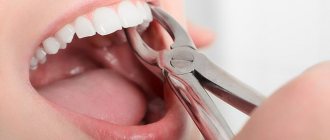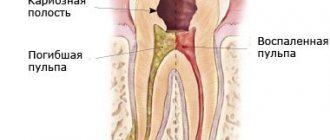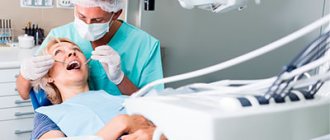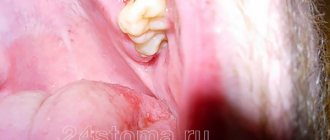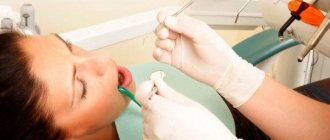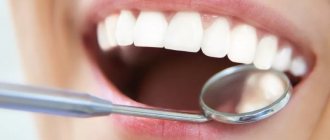Author of the article: Gadzhiev Ruslan Abasovich
Doctor-expert
Specialization: Dentist-therapist
Total work experience: since 2011
Reading time 7-8 minutes
Most often, visits to the dentist occur when pain occurs. After some procedures, for example, after removing nerves, patients expect that pain in such a tooth will never bother them again. But, over time, discomfort begins to be felt under the filling, which does not go away on its own even after taking medications. To understand why a dead tooth hurts, you need to understand and find out what exactly may be causing the discomfort.
What teeth are called dead?
The concept of “dead” is rather common, but in medicine such teeth are called pulpless (without pulp - loose fibrous tissue penetrated by nerve endings, lymphatic and blood vessels).
If living teeth are those in which there is a nerve that provides nutrition and growth, then dead teeth practically cease to receive nutrients. But, even being separated from the nervous and circulatory systems, they continue to remain a component of the dentofacial apparatus and affect the state of other units in the series.
Can a tooth hurt after nerve removal?
The pulp is a thin bundle of nerves, blood vessels and ligaments. It fills the entire internal cavity of the tooth. The condition and sensitivity of the unit, the strength of the enamel layer and even the color of the enamel depend on it.
Due to advanced inflammation, damage to the pulp zone occurs. Then pulpitis develops. Subjectively, a person feels it as an acute pain that appears during temperature changes and mechanical impact. To prevent further spread of the inflammatory process, the doctor removes the inflamed pulp, cleans the dental canals and covers them with filling material.
After depulpation, the tooth stops responding to stimuli. That is, in fact, he should not be sick. However, people often come to the dental clinic complaining of pain in the pulpless unit. With what it can be connected?
Reasons why a dead tooth hurts
Pulp removal is a traumatic procedure after which the tissues need time to recover. During the first two weeks they may go away on their own. If the pain does not go away for a long time or occurs a year or more after removal of the nerve, then the reasons may be:
- poor quality treatment;
- some pathologies;
- individual characteristics.
It makes sense to consider all the reasons why a dead tooth hurts in more detail, so that, if necessary, you can seek dental help in time and prevent complications.
You might be interested in:
Dental treatment
Inflammation of the tooth root
Tooth inflammation
Tooth abscess
Poorly performed treatment
In this case, pain may be a consequence of:
- Root perforation
. Incorrect treatment resulted in the filling material extending beyond the apex of the root and into the tissue of the jaw bone. The body perceives it as a foreign body and, as a result, inflammation appears, accompanied by bursting and throbbing pain. - Incomplete depulpation
. Painful sensations when pressed may also be evidence that the pulp was poorly removed and there are remnants of living tissue in the canals. - Incomplete closure of root canals
. If the doctor incorrectly determined the length of the canal, then part of it may not be filled with filling paste. And this is a reason for infection to develop in the voids and such a dead tooth hurts when pressed. - Poor insulation during channel cleaning
. If during work the doctor poorly or insufficiently isolated the tooth from saliva, then pathogenic organisms enter the canals along with it, infecting the tissues and causing pain. - A piece of tool left behind
. To inspect the canals, special ultra-thin needles are used. Careless or inept handling of them can lead to breakage of the tip, which remains inside, causing the development of infection. - Poor/incomplete removal of caries
. If not all affected tissues are drilled out, then a dead tooth may hurt even under a filling, since pathogenic microflora continues to develop there.
Less critical reasons include installing a filling that is too high. At the same time, there is an increased load on the ligaments, they stretch causing discomfort and pain.
Some pathologies
Among them, a dead tooth most often hurts due to:
- Cysts
. Since the indication for pulp removal is infection, any extraction of root nerves increases the likelihood of an apex cyst. Symptoms may appear a year or even more after treatment and depulpation. - Inflammation of the trigeminal nerve
. If pain is observed when pressing or biting, this may indicate trigeminal neuritis. The reason is the treatment process itself (not the dentist’s mistake). To eliminate the pathology, you need to contact a neurologist.
It will not be possible to diagnose and eliminate these pathologies on your own, therefore, at the first symptoms, you should make an appointment with a dentist and, after an examination, receive high-quality, professional help.
Individual characteristics
The causes of discomfort caused by a dead tooth can be not only pathologies and incorrect treatment, but also the individual characteristics of a person. These include:
- Allergies
. Expressed in the form of intolerance to certain filling materials. Accompanied by pain, swelling and other unpleasant sensations. - Anatomical features of the bite
. An incorrect bite can cause overload of individual teeth, which leads to leaks, injuries and cracks through which infection can enter. - Specific root structure
. If a patient has a non-standard root structure, in some cases it cannot be seen even on an x-ray. Then the doctor relies only on his own feelings and works as if blindly, and the risk of incomplete treatment of the canals increases.
Sometimes, when pressed, a dead tooth hurts not for one reason, but as a result of a whole complex of dental problems. In this case, it will take more time to eliminate pathologies and discomfort in general.
Why does a tooth hurt several years after depulpation?
According to the prevailing belief, after removal of the neurovascular bundle and hermetic obturation, the tooth loses sensitivity and cannot cause pain. However, in some cases, “dead” tissue reacts to temperature stimuli, and the patient feels pulsation and pain, sometimes intense. Very often the phenomenon is accompanied by bleeding, swelling of the gum tissue with the formation of a purulent cyst.
The appointment includes consultation and drawing up a treatment plan with cost determination
sign up for a free consultation
Not ready for an in-person consultation with a doctor? Ask your question by phone
There are a range of causes of pain:
1
If nerve endings are not completely removed, the patient inevitably faces complications. The procedure requires maximum attention, precision and experience from the doctor. Therefore, we recommend that you entrust your treatment to a dentist who has the necessary competencies.
2
Another cause of pain after depulpation is tooth perforation. The situation may arise as a result of a medical error, but in most cases it is associated with demineralization of dental tissue.
3
Very often, due to insufficient width or curvature, the root canal remains incomplete and is not covered with composite material. Over time, bacteria accumulate in the cavity, causing an inflammatory process.
4
A common cause of pain is when the composite extends beyond the root apex. In this case, the chewing load on the tooth and ligamentous apparatus increases. Characteristic is aching pain and its intensification when biting; there is a high risk of developing inflammation of the mucous membrane.
5
Sometimes during the treatment of pulpitis or carious lesions, an infection can be introduced into the canals. The waste products of pathogenic bacteria cause serious complications, which are manifested by severe pain, swelling and abscesses.
6
Another risk factor is failure to follow oral care recommendations.
A common belief is that plaque, and therefore bacteria, do not accumulate on fillings. This is not true; pathogenic microorganisms equally have a destructive effect on both tooth enamel and composite material. The problem is especially relevant for patients with chronic periodontal diseases - in this case, there is a high risk of harmful bacteria from the gum tissue penetrating into the root. It is important to note that cases of tooth inflammation several years after depulpation are not uncommon. The risks of relapse are especially high in people with low immunity and chronic diseases.
Possible complications of ignoring pain
The sensations that may occur in a pulpless tooth clearly indicate the presence of pathology, which must be eliminated as quickly as possible. Otherwise, infection will lead to quite serious consequences:
- complete destruction and/or loss of the tooth;
- acute or chronic gingivitis (gum disease);
- development of periodontitis (inflammation of the tissue surrounding the root, bone tissue of the alveoli and gums);
- chronic inflammation of the gums;
- the appearance of a cyst.
Ignoring the inflammatory process and delaying contact with the dentist can cause the development of systemic infections, which will spread throughout the body through the bloodstream from the periosteum.
How are teeth treated under a crown?
An example is the inflammatory process in the apical (deepest) part of the root canal. In case of poor preparation, the canal may not be sealed to its full depth, which leads to the development of infection. To avoid removing the crown, resection of the apical part of the root is performed. The procedure is performed by a dental surgeon and takes from 30 to 60 minutes.
The doctor drills a small hole in the bone tissue. Through it, he cuts off the poorly sealed tip from the root and removes the purulent sac. It should be noted that this method is characterized by minimal trauma. In addition, the procedure is performed under anesthesia, so the patient does not experience pain or discomfort. After removing a section of the root, the remaining part is carefully “sealed” with a special material for further isolation from microbes.
It is important to understand that it is not always possible to do without crown removal. The final decision on the method of treatment is made by the doctor, who may prescribe an X-ray examination to clarify the cause of inflammation. This is due to the fact that additional root canals or suspected cracks require mandatory removal of the structure.
Preventive actions
Dead teeth can be considered problematic (prone to any dental disease except pulpitis), so they require more careful care. To preserve them and prevent pain, it is necessary to carry out prevention:
- Balanced diet
. Daily meals should contain sufficient amounts of essential minerals and vitamins. - Correct and thorough oral hygiene
. Use a toothpaste recommended by your dentist at least twice a day, and use dental floss and mouthwash after each meal. - Regular visits to the dentist
. By visiting the clinic once every three months, you are guaranteed to be able to identify emerging problems with dead teeth. Once or several times a year, it is worth doing cone beam computed tomography (CBCT), which is the best diagnostic technique today. The finished 3D image shows what is impossible to see in targeted and panoramic images. CBCT results allow you to study the condition of the jaws from all sides, turning images on the monitor at any angle. This technique best identifies problems with pulpless teeth even in the initial stages.
At the same time, the best prevention in this case is to avoid the need to remove the roots. Lead a healthy lifestyle, adhere to the recommended diet, regularly take care of your oral cavity, and then you won’t have to look for the answer to the question: why does a dead tooth hurt and what to do about it.
How to relieve pain at home?
Immediately after the manipulations, the pain is relieved with NSAIDs (non-steroidal anti-inflammatory drugs), including: Tempalgin, Ketorol, Nise, Nimesil, Paracetamol and others.
In case of slight swelling of the gums, as well as injury to the buccal mucosa, rinsing with herbal decoctions or soda solution (1 teaspoon per glass of warm water) is recommended; washing the affected areas with Miramistin or Chlorhexidine is effective. Antiseptic gels, which are applied several times a day to the inflamed area using the application method, have proven themselves to be excellent.
It is important to understand that pain relief is short-term and does not eliminate the cause of the pathological process. To avoid complications, it is necessary to re-examine, as well as re-treat the canals in compliance with the correct technique and antiseptic requirements.
Read also
What to do if your tooth aches
Sometimes aching pain in a tooth can appear for no apparent reason at first glance.
Why do teeth crumble?
Tooth decay in general, and crumbling in particular, is not an aesthetic problem.
Should I take a painkiller or see a doctor?
All kinds of analgesics, as well as folk remedies, have a temporary effect. Pain is a kind of warning system about existing problems. If you do not pay attention to them, drowning them out with painkillers, minor defects will inevitably turn into serious diseases. If previously pulpless teeth that caused discomfort were removed, today they can be treated. Remaining pulp and even fragments of dental instruments can be removed. To do this, the doctor removes the filling material and cleans the canal. Repeated pulp removal in most cases allows you to completely get rid of negative manifestations.
The gum area can also be treated, involving medication, therapeutic or even surgical treatment. Sometimes, to eliminate the pain, it is necessary to treat the adjacent tooth. A person, based on his own feelings, cannot 100% correctly determine the source of inflammation, especially if the roots are located close to each other. We may mistakenly think about problems with one tooth when another needs help.
Contacting our clinic will allow you to accurately identify the defect in the shortest possible time. Diagnosis is carried out on the basis of tests, visual examination and examination of x-rays. Modern equipment makes it possible to repeat depulpation without causing harm to the patient’s hard and soft tissues. To confirm the quality of cleaning of the canals, as well as their filling, a repeated x-ray examination is carried out.
Natural pain after pulpitis treatment
Why does a tooth hurt after pulpitis treatment if there are no complications?
After the anesthesia wears off, pain may appear in the area of the causative tooth, and normally this condition is characterized by the following symptoms:
- the pain gradually subsides - an unpleasant sensation of a certain degree of severity may persist for some time, but it does not intensify;
- already 1–3 days after the procedure, the pain noticeably subsides;
- there are no other symptoms - bleeding, severe swelling and redness of the gums, increased body temperature, general weakness.
It is difficult to predict how much a tooth hurts after treatment for pulpitis; it depends on the individual characteristics, the specific tooth and the complexity of the root system, the presence or absence of concomitant diseases. The norm is that moderate pain persists for up to 7 days. Important: the intensity of pain becomes less over time.
It is difficult to talk about the norm if there are such “indicators” of complications as fever, swelling, too much pain, including increasing pain. There are several possible complications of endodontic treatment of pulpitis.
Incorrectly performed treatment
Poor quality materials and violation of treatment technology also cause pain. Reasons for such complications include:
- the channels are not completely cleaned;
- the nerve was partially removed;
- cavities remain under the filling material, leading to tissue destruction and the development of inflammatory processes;
- During filling, the material is moved beyond the apex of the root canal;
- The doctor did not notice any branches or lateral additional channels during treatment.
